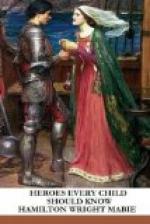The Danish wars began again in 893. For years now there was a great deal of fighting. Two large bodies of Danes, one of them under the famous chief Hasting, landed in Kent in 893 and fixed themselves in fortresses which they built. And the Danes who had settled in Northumberland and East-Anglia helped them, though they had all sworn oaths to King Alfred, and those in East-Anglia had also given hostages. There was fighting all over the south of England throughout 894, and the King had to go constantly backward and forward to keep up with the Danes. One time Alfred took a fort in Kent, in which were the wife and two sons of Hasting. Now Hasting had not long before given oaths and hostages to Alfred, and the two boys had been baptised, the King being godfather to one of them and Alderman Aethelred to the other. But Hasting did not at all keep to his oath, but went on plundering all the same. Still, when the boys and their mother were taken, Alfred would not do them any harm, but gave them up again to Hasting.
In 897 we read that Alfred made some improvements in his ships. “They were full-nigh twice as long as the others; some had sixty oars, some more; they were both swifter and steadier and eke higher than the others; they were neither on the Frisian shape nor on the Danish, but as himself thought that they useful might be.” These new ships seem to have done good service, though one time they got aground, seemingly because they were so large, and the Danes were therefore able to sail out before them. These sea-fights along the south coast were nearly the last things that we hear of in Alfred’s reign. The crews of two Danish ships were brought to Winchester to Alfred and there hanged. One cannot blame him for this, as these Danes were mere pirates, not engaged in any lawful war, and many of them had been spared, and had made oaths to Alfred, and had broken them, over and over again.
This was in 897; the rest of King Alfred’s reign seems to have been spent in peace. In 901 the great King died himself. He was then only fifty-two years old. Alfred’s wife, the Lady Ealhswyth, lived a little while after her husband, till 903 or 905. King Alfred was buried at Winchester in the New Minster which he himself began to found and which was finished by his son Edward. It then stood close to the Old Minster, that is, the cathedral church. Afterward it was moved out of the city and was called Hyde Abbey. But you cannot see King Alfred’s grave there now, because everything has been destroyed, and the bones of the great King have been turned out, to make room for a prison.
CHAPTER XI
THE CID




